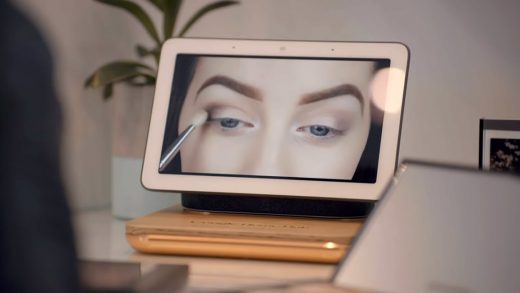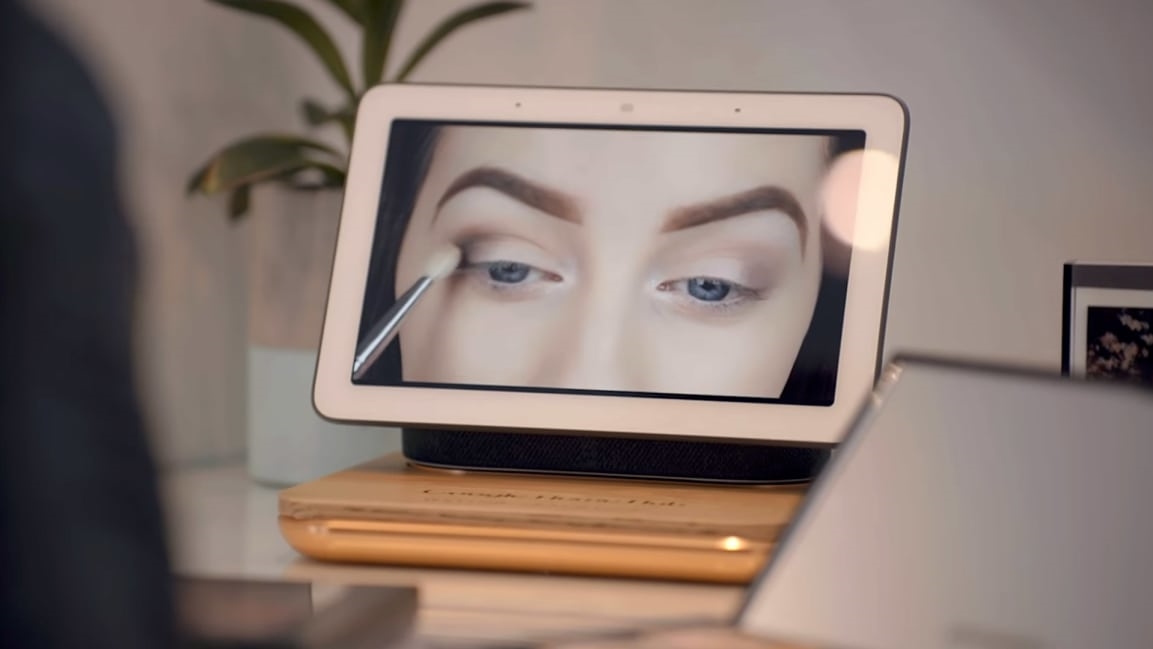Google Home Hub is a makeup how-to machine for your vanity
On a Tuesday morning in November, a crowd of immaculately groomed bloggers gathers at 8 a.m. inside a Sephora store to munch on tiny avocado toasts, their lipstick never budging. They’re there to listen to a pitch from Google on why they should make room for the company’s new Home Hub smart display on their vanity. Google has teamed up with Sephora to show off the device’s usefulness as a way to call up tutorial videos on YouTube.
Before the presentation starts, Sephora’s beauty director Myisha Sewell, dressed in what looks like black-and-white polka-dot silk pajamas, carefully arranges an array of compacts and liners next to a blush-colored Google Home Hub on a pedestal that will serve as a demo vanity.
“The fact that this is hands-free is actually pretty great,” she says. “You’re not going to get makeup all over your phone, you’re not going to have to balance your laptop on top of your bathroom cabinet and have a disaster happen. It’s something really easy that you can integrate into your life.” Yoice control via the Google Assistant–new this year inside of YouTube–not only pulls up videos and plays and pauses on demand, but can also fast forward to the right spot.
Sewell begins by asking the Assistant for an eyebrow tutorial by Sephora. While she’s keen to promote the Sephora brand as part of this marketing stunt, the beauty of putting YouTube on your vanity is that it offers a full library of makeup tutorials by both amateurs and influencers.
In fact, tutorials of all sorts are a big driver for YouTube. A smidge more than half of all users say YouTube is an important source for learning how to do something they’ve never done before, according to a recent survey from Pew Research. The data suggests that tutorials, more than time killers or product reviews, lure people to the platform.
That’s why it wasn’t particularly surprising when, in October, Google decided to put $20 million into educational videos. When that news was announced, there was much fanfare about the company trying to fill out its platform with content that brands will feel safe putting ads against. Prior to the announcement, a story in the U.K.’s Sunday Times reported that brands were seeing their ads alongside bigoted and extremist content. Of course, Google would want to distance itself from its worst content, but educational videos are a big draw unto themselves.
In 2017, YouTube videos with “how-to” in the title garnered more than a billion watch hours, up 75% from 2015. People conducted 81 million searches for beauty how-to’s alone in the last year. On their own, makeup gurus Nikki De Jager and James Charles have 11 and 10 million subscribers, respectively.
At home on my vanity, a sea-foam-colored Google Home Hub fits in neatly among a long, skinny wooden jewelry box and an old green gift box my mother decoupaged with pictures of Bob Dylan when she was a teenager. I’m fairly inconsistent when it comes to makeup. Sometimes I wear it, sometimes I don’t. When it comes to my prowess, I’m somewhere in the middle: I don’t understand foundation, but have mastered a cat eye.
I recently purchased a new lipstick, and thought the Home Hub’s arrival would be a good opportunity to actually learn how to apply it. I call upon Google to find me a video for how to put on lipstick. In the video that Google chooses, the woman doesn’t use lip liner. Instead she takes a small brush, dabs it on the lipstick, and then outlined her lips using the brush before filling in her lips with the stick. I learn something new. I also learn that you can use concealer to touch up lipstick mistakes afterwards—a new favorite trick.
There are other things I would love to learn about besides makeup, like how to retile a kitchen backsplash or reassemble a coffee grinder (don’t ask). Unfortunately, the Home Hub is tethered to an electrical outlet, so it cannot easily accompany me around the house as I look for new projects to involve it in. (This is probably where Google would recommend I get more than one of the $150 device.)
More than tutorials
There are, of course, other things the Home Hub can do on my vanity. It can remind me what’s on my calendar for the day or tell me about the weather or traffic, though that’s all relatively standard fare for home assistants. I can also shop–say to pick up a new blush when I’m running out. However, shopping is limited to shops on Google Express, which means that choices are skimpy. Sephora, for example, doesn’t sell its products through there.
I searched for a certain Stila blush. Google Assistant said it couldn’t find the one I was looking for, and then told me, wistfully, that it’s still learning. When it found another item I asked about, a generic foundation, it was hard to get the right shade. Product details were also scant, but the “add to cart” button was front and center.
I attempted to buy the same products on Amazon’s Echo. Its Alexa assistant was able to find the Stila blush, though it couldn’t find the exact shade I wanted. So it prompted me to look inside the Alexa app to make more finite decisions. Inside the app, I could swap the shade from its default to the one I was looking for.
Though Alexa can help me buy makeup, even the screen-equipped Echo Show isn’t very good at teaching me to put it on, since it has access to YouTube only through a browser-based experience with no voice control. Google’s Home Hub has the advantage here for sure, though, Facebook’s similarly styled video messaging device, Portal, also has YouTube access (and Alexa). While these devices are not all specifically jockeying for the most well-lit spot on the vanity, they all want to be a part of the home, and there may not be space for them all.
Back at Sephora, after the presentation is over, bloggers hover around a mirrored bar, inquiring about the free makeovers compliments of Google and Sephora. A few hang back, clustering around the Home Hub and asking questions. A representative for Google again shows off the voice-command capabilities, shuffling one video forward and back, and then telling the Assistant to pause. “I also ask her silly questions,” said the representative.
“Is this compatible with Alexa?” one of the bloggers asks. Unfortunately no, the Google Home Hub is not compatible with Alexa, answers the rep.
“Oh well, we’re an Alexa household,” the blogger says.
Fast Company , Read Full Story
(2128)



